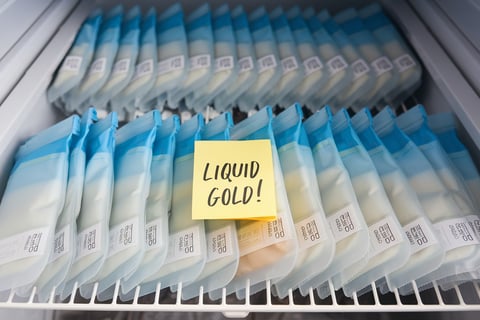Pumping & Milk Storage for New Moms
Navigating the world of breast pumps and milk storage can feel like a crash course in engineering—flanges, suction levels, and a machine that somehow mimics your baby’s sucking rhythm. In this guide, I’ll walk you through everything you need to know about pumping, from choosing the right breast pump to creating a schedule, storing milk safely, and troubleshooting common challenges. Whether you're pumping to build a stash, heading back to work, or just figuring things out one session at a time, this post is here to make your journey smoother (and maybe even a little less overwhelming). You’ve got this, mama! ❤️
BREASTFEEDING & NEWBORN FEEDING


I remember the first time I set up my breast pump. I had my cozy little nursing nook, a fresh bottle of water, snacks within reach, and a newfound confidence that I totally knew what I was doing. Then, reality hit—flanges, suction settings, and the unnerving sound of a machine mimicking a baby’s sucking rhythm. I stared at the pump like it was some kind of high-tech contraption I was supposed to master overnight. Spoiler alert: I didn’t. But with time, patience, and lots of trial and error, I figured out the ins and outs of pumping and milk storage—and now I’m here to help you do the same.
Getting Started with Pumping
Breastfeeding is a beautiful, natural way to nourish your baby, but let’s be honest—sometimes, mama needs a break. Whether you're heading back to work, need a little extra sleep, or simply want your partner to take over a feeding, pumping can be a lifesaver.
The key to a successful pumping journey starts with choosing the right breast pump. There are manual pumps, single electric pumps, and double electric pumps, and each has its own benefits. If you’re planning to pump frequently, a high-quality double electric pump can save you loads of time. If you just need to express milk occasionally, a manual or single electric pump might be all you need.
Before you commit to a pump, check if your insurance covers one—many do! And if you’re still feeling overwhelmed, reading reviews or asking other moms for recommendations can help you narrow down the best choice for your lifestyle.
Once you have your pump, you’ll also need some essentials: breast shields that fit properly (because an incorrect fit can make pumping painful and inefficient), storage bags or bottles, and a comfortable nursing bra to keep everything in place. And trust me on this—having snacks and water nearby will make your pumping sessions much more enjoyable.
When to Start Pumping
If you’re exclusively nursing and have no immediate need to build a stash, you don’t have to start pumping right away. However, if you're returning to work or need to supplement breastfeeding, many lactation consultants recommend waiting until your milk supply regulates—usually around 3 to 5 weeks postpartum.
If your baby struggles with latching or you have a preemie, pumping sooner can help establish your supply. Listen to your body and do what works best for you. Some moms start pumping early to build a freezer stash, while others wait until they truly need to.
Creating a Pumping Schedule
Establishing a routine can make pumping feel less like a chore and more like a predictable part of your day. If you’re pumping to build a stash before returning to work, try adding a morning session when your supply is typically highest. If you’re exclusively pumping, aim for about 8-10 sessions per day in the beginning to mimic your baby’s natural feeding schedule.
And let’s not forget about night pumping! While it may be tempting to skip those late-night sessions, nighttime pumping is crucial for keeping up supply since prolactin (the milk-making hormone) peaks at night.
Balancing direct nursing with pumping? Try pumping after nursing sessions to collect any leftover milk or in between feedings to signal your body to make more. The best schedule is the one that works for you and your baby.
Proper Breast Milk Storage
Now that you’ve pumped that liquid gold, you want to store it safely! Here’s a quick guide to keeping your milk fresh:
Room Temperature (up to 77°F / 25°C): Safe for 4 hours.
Refrigerator (39°F / 4°C): Safe for up to 5 days.
Freezer (0°F / -18°C): Best used within 6 months but can be stored up to 12 months.
Deep Freezer (-4°F / -20°C): Best used within 12 months.
Always label your milk with the date and time it was pumped, and use the oldest milk first. When using storage bags, lay them flat to freeze—they’ll take up less space and thaw faster when you need them.
Handling & Thawing Milk
Breast milk isn’t just about storage—it’s about handling it properly, too! Always wash your hands before handling milk, and ensure that all storage containers are BPA-free and sanitized.
To thaw frozen milk, place it in the refrigerator overnight or run it under warm water. Never microwave breast milk—it can create hot spots that burn your baby’s mouth and destroy essential nutrients. If your baby doesn’t finish a bottle, you can keep the leftover milk at room temperature for up to two hours, but after that, it’s best to discard it.
Common Pumping Challenges & Solutions
Like everything in motherhood, pumping comes with its fair share of challenges. Here are some common ones and how to tackle them:
1. Low Milk Output – If your pump isn’t extracting much milk, check your flange size (a poor fit can impact milk removal), increase your water intake, and try massaging your breasts before and during pumping. Power pumping (short, frequent sessions mimicking cluster feeding) can also help increase supply.
2. Pain While Pumping – Pumping shouldn’t hurt! If it does, reduce the suction level, check for proper flange fit, and make sure your nipples aren’t rubbing against the sides of the flange tunnel.
3. Clogged Ducts – If you notice a painful lump in your breast, try warm compresses, massage, and frequent nursing or pumping to clear the blockage.
4. Pumping at Work – Returning to work while breastfeeding? Plan ahead by talking to your employer about pumping accommodations. Bring a small cooler to store milk and pump during breaks to maintain supply.
Final Thoughts: Making Pumping Work for You
Pumping is an incredible tool, but it doesn’t have to be all-consuming. Whether you’re exclusively pumping, pumping occasionally, or supplementing nursing with expressed milk, remember: you’re doing an amazing job.
There were days when I felt like I was hooked up to a machine more than I was holding my baby, but over time, I found balance. Give yourself grace, celebrate the small wins (like getting that extra ounce of milk), and remind yourself that any amount of breast milk your baby gets is a victory.
So grab your pump, get comfy, and know that you are not alone in this journey. Whether you’re building a stash, pumping at work, or just making it through one session at a time—you’ve got this, mama! ❤️




